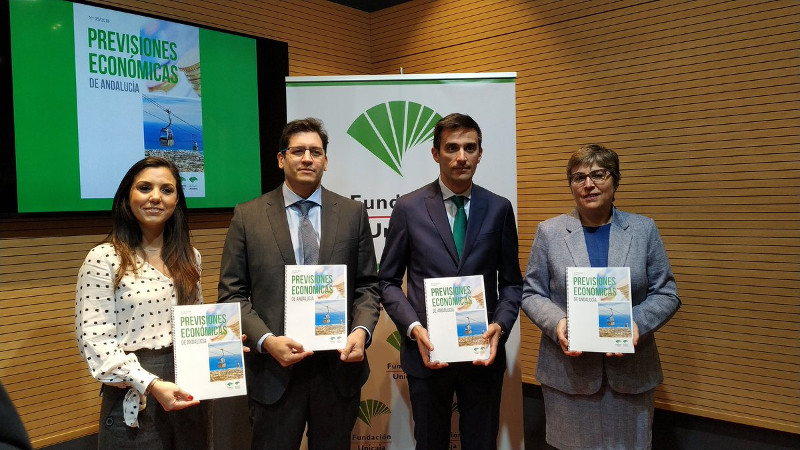The issue number 95 of the quarterly report ‘Previsiones Económicas de Andalucía’ (Economic Forecast for Andalusia), corresponding to Winter 2018/19, prepared, as in previous editions, by Analistas Económicos de Andalucía (research company of Grupo Unicaja) and sponsored by Fundación Unicaja, has been presented today at the Sala Unicaja de Conciertos María Cristina, in Malaga.
The report, which analyses the recent evolution of domestic and international economies, of Andalusia and its provinces, includes the growth forecasts for the GDP and its components for 2018 and 2019, as well as the main variables of the labour market, with growth estimations for each Andalusian province.
The report highlights the following:
Economic Environment (international and Spanish economies)
In 2018, the world economy maintains an expansionary profile, although a certain slowdown has been noticed in recent months, due mainly to the partial materialization of some episodes of uncertainty, such as the adoption of protectionist measures in international trade and the persistence of geopolitical risks.
In this context, the Spanish economy continues with its growth trend, with year-on-year variation rates in production of around 2.5%. Despite the loss of dynamism, the increase in the activity would be higher than that of the Eurozone, a trend expected to be maintained in 2019, although the most recent outlooks point towards a certain slowdown due to the moderate contribution of the internal demand components.
Andalusian Economy
The latest information, related to the third quarter of 2018, shows that the Andalusian economy recorded a quarter-on-quarter growth of 0.6%, 0.1 p.p. more than in the previous quarter. Year-on-year GDP growth stood at 2.3%.
As per its composition, the growth is underpinned by the positive contribution of the internal demand, of 2.8 p.p., 0.5 p.p. less than in the previous quarter (3.3 p.p.). This lower contribution is due to a moderate growth of household expenditure and investment (1.9% and 5.8% respectively, year-on-year) and to an increase in Public Administration expenditure (2.2%). On the other hand, the negative contribution of the net external balance has been reduced to -0.5 p.p., as exports grew at faster pace (3.3%) than in the previous quarter, and imports have moderated their growth, posting a year-on-year variation of 3.9%.
From the point of view of supply, construction has grown strongly (7.8% year-on-year), and the sector of services is the only one which has grown at a faster pace than in the previous quarter (2.6%). On the other hand, the agricultural sector has grown by 1.8%, whereas industry has decreased by 1.0%.
Job creation has increased, with the number of persons in employment up 2.7% year-on-year in the third quarter (2.4% in the second quarter), due to a rise in non-agricultural sectors. The number of unemployed persons decreased by 10.7%, and the labour force is down by 0.7%. Unemployment stands at 22.9% (14.6% in Spain), 2.6 p.p. lower than the rate of the previous year.
In relation to growth outlooks for 2018 and 2019, Analistas Económicos de Andalucía estimate, in the absence of the data corresponding to the fourth quarter, a growth of 2.4% in the Andalusian economy for the whole 2018, 0.1 p.p. less than September forecasts and due mainly to the reduced dynamism in the industrial activity and private consumption. On the side of supply, the estimations indicate growth rates ranging from 0.6% in the industrial sector to 7.5% in construction, and a significant growth of 2.5% in the sector of services. On the side of demand, both private and Public Administration consumptions could grow by 2.3%, with investments increasing by 5.5%.
This growth would be slightly moderated in 2019, reaching 2.3%, a rate similar to that of the Spanish economy. The internal demand will continue to post a significant increase, although lower than in 2018, with household and Public Administration consumptions up 2.2% and 1.8% respectively, while investments would grow by 3.8%. From the side of supply, a positive contribution of all sectors is expected, with remarkable growths in construction and services (3.6% and 2.3%).
With regard to the labour market, an average growth of 2.6% in employment is expected for 2018, 0.2 p.p. more than in September outlook, due to the higher growth of employment in construction and services. With the exception of the agricultural sector, employment would grow in all the sectors, especially in construction. The number of unemployed would decrease by 9.9%, bringing the unemployment rate down to 23.1%, 2.4 p.p. less than in 2017. In 2019, the unemployment rate would stand at 21.4% as year average (13.7% in Spain), following a growth in employment of 2.2% in a context where the labour force would remain stable.
Territorial Analysis (Andalusian provinces)
The third quarter of 2018 has witnessed a general increase in the economic activity in Andalusian provinces, with year-on-year increases exceeding the region’s average recorded in the Malaga (2.7%), Seville (2.5%) and Cadiz (2.5%). For the whole 2018, the forecasts indicate a general growth of the economic activity, with significant increases in Malaga (2.8%), Seville (2.6%) and Cadiz (2.6%).
The first estimations for 2019 indicate that the economic activity will grow in all the Andalusian provinces, although at a slightly slower pace than in 2018, with growth rates exceeding the Andalusian average in Malaga (2.6%), Seville (2.6%), Cadiz (2.4%) and Granada (2.4%).
The issue number 95 of the quarterly report ‘Previsiones Económicas de Andalucía’ (Economic Forecast for Andalusia), corresponding to Winter 2018/19, prepared, as in previous editions, by Analistas Económicos de Andalucía (research company of Grupo Unicaja) and sponsored by Fundación Unicaja, has been presented today at the Sala Unicaja de Conciertos María Cristina, in Malaga.
The report, which analyses the recent evolution of domestic and international economies, of Andalusia and its provinces, includes the growth forecasts for the GDP and its components for 2018 and 2019, as well as the main variables of the labour market, with growth estimations for each Andalusian province.
The report highlights the following:
Economic Environment (international and Spanish economies)
In 2018, the world economy maintains an expansionary profile, although a certain slowdown has been noticed in recent months, due mainly to the partial materialization of some episodes of uncertainty, such as the adoption of protectionist measures in international trade and the persistence of geopolitical risks.
In this context, the Spanish economy continues with its growth trend, with year-on-year variation rates in production of around 2.5%. Despite the loss of dynamism, the increase in the activity would be higher than that of the Eurozone, a trend expected to be maintained in 2019, although the most recent outlooks point towards a certain slowdown due to the moderate contribution of the internal demand components.
Andalusian Economy
The latest information, related to the third quarter of 2018, shows that the Andalusian economy recorded a quarter-on-quarter growth of 0.6%, 0.1 p.p. more than in the previous quarter. Year-on-year GDP growth stood at 2.3%.
As per its composition, the growth is underpinned by the positive contribution of the internal demand, of 2.8 p.p., 0.5 p.p. less than in the previous quarter (3.3 p.p.). This lower contribution is due to a moderate growth of household expenditure and investment (1.9% and 5.8% respectively, year-on-year) and to an increase in Public Administration expenditure (2.2%). On the other hand, the negative contribution of the net external balance has been reduced to -0.5 p.p., as exports grew at faster pace (3.3%) than in the previous quarter, and imports have moderated their growth, posting a year-on-year variation of 3.9%.
From the point of view of supply, construction has grown strongly (7.8% year-on-year), and the sector of services is the only one which has grown at a faster pace than in the previous quarter (2.6%). On the other hand, the agricultural sector has grown by 1.8%, whereas industry has decreased by 1.0%.
Job creation has increased, with the number of persons in employment up 2.7% year-on-year in the third quarter (2.4% in the second quarter), due to a rise in non-agricultural sectors. The number of unemployed persons decreased by 10.7%, and the labour force is down by 0.7%. Unemployment stands at 22.9% (14.6% in Spain), 2.6 p.p. lower than the rate of the previous year.
In relation to growth outlooks for 2018 and 2019, Analistas Económicos de Andalucía estimate, in the absence of the data corresponding to the fourth quarter, a growth of 2.4% in the Andalusian economy for the whole 2018, 0.1 p.p. less than September forecasts and due mainly to the reduced dynamism in the industrial activity and private consumption. On the side of supply, the estimations indicate growth rates ranging from 0.6% in the industrial sector to 7.5% in construction, and a significant growth of 2.5% in the sector of services. On the side of demand, both private and Public Administration consumptions could grow by 2.3%, with investments increasing by 5.5%.
This growth would be slightly moderated in 2019, reaching 2.3%, a rate similar to that of the Spanish economy. The internal demand will continue to post a significant increase, although lower than in 2018, with household and Public Administration consumptions up 2.2% and 1.8% respectively, while investments would grow by 3.8%. From the side of supply, a positive contribution of all sectors is expected, with remarkable growths in construction and services (3.6% and 2.3%).
With regard to the labour market, an average growth of 2.6% in employment is expected for 2018, 0.2 p.p. more than in September outlook, due to the higher growth of employment in construction and services. With the exception of the agricultural sector, employment would grow in all the sectors, especially in construction. The number of unemployed would decrease by 9.9%, bringing the unemployment rate down to 23.1%, 2.4 p.p. less than in 2017. In 2019, the unemployment rate would stand at 21.4% as year average (13.7% in Spain), following a growth in employment of 2.2% in a context where the labour force would remain stable.
Territorial Analysis (Andalusian provinces)
The third quarter of 2018 has witnessed a general increase in the economic activity in Andalusian provinces, with year-on-year increases exceeding the region’s average recorded in the Malaga (2.7%), Seville (2.5%) and Cadiz (2.5%). For the whole 2018, the forecasts indicate a general growth of the economic activity, with significant increases in Malaga (2.8%), Seville (2.6%) and Cadiz (2.6%).
The first estimations for 2019 indicate that the economic activity will grow in all the Andalusian provinces, although at a slightly slower pace than in 2018, with growth rates exceeding the Andalusian average in Malaga (2.6%), Seville (2.6%), Cadiz (2.4%) and Granada (2.4%).
The issue number 95 of the quarterly report ‘Previsiones Económicas de Andalucía’ (Economic Forecast for Andalusia), corresponding to Winter 2018/19, prepared, as in previous editions, by Analistas Económicos de Andalucía (research company of Grupo Unicaja) and sponsored by Fundación Unicaja, has been presented today at the Sala Unicaja de Conciertos María Cristina, in Malaga.
The report, which analyses the recent evolution of domestic and international economies, of Andalusia and its provinces, includes the growth forecasts for the GDP and its components for 2018 and 2019, as well as the main variables of the labour market, with growth estimations for each Andalusian province.
The report highlights the following:
Economic Environment (international and Spanish economies)
In 2018, the world economy maintains an expansionary profile, although a certain slowdown has been noticed in recent months, due mainly to the partial materialization of some episodes of uncertainty, such as the adoption of protectionist measures in international trade and the persistence of geopolitical risks.
In this context, the Spanish economy continues with its growth trend, with year-on-year variation rates in production of around 2.5%. Despite the loss of dynamism, the increase in the activity would be higher than that of the Eurozone, a trend expected to be maintained in 2019, although the most recent outlooks point towards a certain slowdown due to the moderate contribution of the internal demand components.
Andalusian Economy
The latest information, related to the third quarter of 2018, shows that the Andalusian economy recorded a quarter-on-quarter growth of 0.6%, 0.1 p.p. more than in the previous quarter. Year-on-year GDP growth stood at 2.3%.
As per its composition, the growth is underpinned by the positive contribution of the internal demand, of 2.8 p.p., 0.5 p.p. less than in the previous quarter (3.3 p.p.). This lower contribution is due to a moderate growth of household expenditure and investment (1.9% and 5.8% respectively, year-on-year) and to an increase in Public Administration expenditure (2.2%). On the other hand, the negative contribution of the net external balance has been reduced to -0.5 p.p., as exports grew at faster pace (3.3%) than in the previous quarter, and imports have moderated their growth, posting a year-on-year variation of 3.9%.
From the point of view of supply, construction has grown strongly (7.8% year-on-year), and the sector of services is the only one which has grown at a faster pace than in the previous quarter (2.6%). On the other hand, the agricultural sector has grown by 1.8%, whereas industry has decreased by 1.0%.
Job creation has increased, with the number of persons in employment up 2.7% year-on-year in the third quarter (2.4% in the second quarter), due to a rise in non-agricultural sectors. The number of unemployed persons decreased by 10.7%, and the labour force is down by 0.7%. Unemployment stands at 22.9% (14.6% in Spain), 2.6 p.p. lower than the rate of the previous year.
In relation to growth outlooks for 2018 and 2019, Analistas Económicos de Andalucía estimate, in the absence of the data corresponding to the fourth quarter, a growth of 2.4% in the Andalusian economy for the whole 2018, 0.1 p.p. less than September forecasts and due mainly to the reduced dynamism in the industrial activity and private consumption. On the side of supply, the estimations indicate growth rates ranging from 0.6% in the industrial sector to 7.5% in construction, and a significant growth of 2.5% in the sector of services. On the side of demand, both private and Public Administration consumptions could grow by 2.3%, with investments increasing by 5.5%.
This growth would be slightly moderated in 2019, reaching 2.3%, a rate similar to that of the Spanish economy. The internal demand will continue to post a significant increase, although lower than in 2018, with household and Public Administration consumptions up 2.2% and 1.8% respectively, while investments would grow by 3.8%. From the side of supply, a positive contribution of all sectors is expected, with remarkable growths in construction and services (3.6% and 2.3%).
With regard to the labour market, an average growth of 2.6% in employment is expected for 2018, 0.2 p.p. more than in September outlook, due to the higher growth of employment in construction and services. With the exception of the agricultural sector, employment would grow in all the sectors, especially in construction. The number of unemployed would decrease by 9.9%, bringing the unemployment rate down to 23.1%, 2.4 p.p. less than in 2017. In 2019, the unemployment rate would stand at 21.4% as year average (13.7% in Spain), following a growth in employment of 2.2% in a context where the labour force would remain stable.
Territorial Analysis (Andalusian provinces)
The third quarter of 2018 has witnessed a general increase in the economic activity in Andalusian provinces, with year-on-year increases exceeding the region’s average recorded in the Malaga (2.7%), Seville (2.5%) and Cadiz (2.5%). For the whole 2018, the forecasts indicate a general growth of the economic activity, with significant increases in Malaga (2.8%), Seville (2.6%) and Cadiz (2.6%).
The first estimations for 2019 indicate that the economic activity will grow in all the Andalusian provinces, although at a slightly slower pace than in 2018, with growth rates exceeding the Andalusian average in Malaga (2.6%), Seville (2.6%), Cadiz (2.4%) and Granada (2.4%).
Download Previsiones Económicas de Andalucía Nº95/2018
Download Tablas y gráficos del informe 'Previsiones Económicas de Andalucía Nº95/2018'



